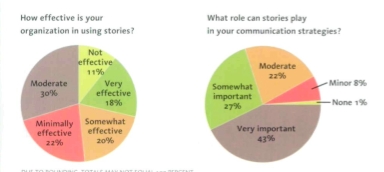“Cousin” Jon Hansen recently wrote to me to tell me that he frequently tells stories when he speaks about procurement.
Stories also appear in his Procurement Insights blog, such as these entries:
“Cousin” Jon Hansen recently wrote to me to tell me that he frequently tells stories when he speaks about procurement.
Stories also appear in his Procurement Insights blog, such as these entries:
 If you want to stretch your storytelling muscles, a great technique is to find interesting visuals and construct your own story about what’s going on in the visual. I had a blast with this type of exercise at a seminar during my PhD program in which we made up stories about images on New Yorker covers, as seen here.
If you want to stretch your storytelling muscles, a great technique is to find interesting visuals and construct your own story about what’s going on in the visual. I had a blast with this type of exercise at a seminar during my PhD program in which we made up stories about images on New Yorker covers, as seen here.
An exhibition at the Fahey/Klein Gallery in Los Angeles until March 22 provides superb visuals for crafting stories. The story you craft may be nothing like what the artist, Achim Lippoth, had in mind, but no matter.
The exhibition, Achim Lippoth Storytelling, features a selection of color photographs from his latest publication, Pictures. This dramatic exploration of children’s behavior in a highly orchestrated and designed setting highlights the complex relationship between young minds and the adult expectations to which they both rebel and conform.
See 36 striking images here.
Children are the actors here, while adults are at most the decoration…The pictorial spaces are like stage sets, whether outdoors or in the studio. The photographer never leaves the choreography of his characters or the orchestration of light and colour up to the coincidence of capturing the right moment…After all, Lippoth’s world is a stage, and he is the sole director.
– Thomas Wiegand, Achim Lippoth: Pictures, Kehrer 2007
In the extended entry, see a press release about the exhibition.
The Fahey/Klein Gallery is pleased to present Achim Lippoth Storytelling, featuring a selection of color photographs from his latest publication, Pictures. This dramatic exploration of children’s behavior in a highly orchestrated and designed setting highlights the complex relationship between young minds and the adult expectations to which they both rebel and conform. “Children are the actors here, while adults are at most the decoration…The pictorial spaces are like stage sets, whether outdoors or in the studio. The photographer never leaves the choreography of his characters or the orchestration of light and colour up to the coincidence of capturing the right moment…After all, Lippoth’s world is a stage, and he is the sole director” (Thomas Wiegand, Achim Lippoth: Pictures, Kehrer 2007).
Lippoth’s series, from 2002 to the present, focuses on individual sequences which investigate a particular theme or obstacle children face as they transition into adulthood: innocence, discipline, conformity, consumerism, camaraderie, desperation, tomfoolery, and rage. Throughout each, children are depicted as the sole agents of the action. It is their world: the adults merely live in it. When in contact with the adult world, they are always at odds with its requirements. For Lippoth, it is only when these children lack adult intervention that they spontaneously conform to the social demands of their peers.
Each series draws on Lippoth’s inspirations from art and media history, but his unique synthesis of these influences — coupled with his theatrical arrangements and sharp focusing techniques — create his own reality in the frame. Each individual sequence, despite their subject differences, seeks to capture an epic moment of childhood. From organized recess to classroom antics to roughhousing with the boys, Lippoth freezes iconic moments of childhood: life as it is imagined in the perfect still frame of memory.
Achim Lippoth was born in Ilsofen, Germany in 1968. He graduated from Byrom College at Manchester in 1986 and resumed his art studies at the University of Cologne, where he graduated in 1992. Shortly thereafter, Lippoth began his career as a freelance photographer. In 1995, Lippoth established “Kid’s Wear Magazine,” designed originally as a forum for designers and retailers of children’s fashion. The magazine has also garnered a substantial audience of photography aficionados because of its impressive production and design content. Lippoth has received numerous honors and awards for both his commercial and artistic photographic work in print, television advertisement, and technical skill, including the IPA 2006 Professional Photographer of the Year award, Clio Awards Gold Category in Print (2006), and Epica Award for Print. Achim Lippoth’s editorial work has been featured in Life Magazine, The New York Times Magazine, and Vogue. Lippoth currently lives in Cologne, Germany.
Press Images Available Upon Request.
Fahey/Klein Gallery
148 N. La Brea Ave.
Los Angeles, CA 90036
(323) 934-2250
In an earlier entry, I noted the International Day for Sharing Life Stories (May 16). One of the major sponsors of that day is the Museum of the Person, which has branches in the US (Indiana), Canada, Brazil, and Portugal. The US site notes that it is dedicated to “strengthening community through storysharing.” The site goes on to say:
This site commemorates and celebrates the lives of people from all walks of life – those who give heft to the fabric of our community through their daily work, play, traditions and dreams.
This is a place to share your story with family and community. We welcome you and invite you to share with us.
The museum offers individual stories and a form for submitting one’s own story. Hmmmm…. the form asks for one’s connection with Indiana. What if one doesn’t have a connection?
 Similar to OurStory, which I wrote about yesterday, is Dandelife, which describes itself as a social biography network, a “social network built around the telling of your life’s stories.” The Dandelife folks coined the term “lifecasting,” which is apparently what you do at Dandelife.
Similar to OurStory, which I wrote about yesterday, is Dandelife, which describes itself as a social biography network, a “social network built around the telling of your life’s stories.” The Dandelife folks coined the term “lifecasting,” which is apparently what you do at Dandelife.
I am fascinating by this concept of socially constructing our identities in the virtual world. How do we portray our identities, our stories, ourselves online differently from the way we do in other venues? No need to ask which one is real; they are all real. I believe there is no objective reality; reality is socially constructed through language, stories, conversations, etc.
Both Our Story and Dandelife veer toward constructing reality visually – with lots of photos and video. As a words gal, I’m not quite on board with this approach, although I recognize its value.
For a very fleshed-out example of a social biography on the Dandelife network, see this one by founder http://www.dandelife.com/kga245 Kelly Abbott.
![]() I’ve written before about Lori Silverman’s excellent book, Wake Me When the Data Is Over, one of the few books on organizational storytelling to provide copious examples of storytelling in use in organizations.
I’ve written before about Lori Silverman’s excellent book, Wake Me When the Data Is Over, one of the few books on organizational storytelling to provide copious examples of storytelling in use in organizations.
Just wanted to also point out that her Web site of the same name is an excellent resource, with a very nice collection of articles available for free download.
 The International Association of Business Communicators conducted one of the most comprehensive studies ever on storytelling in organizations in 2006, and Terrence Gargiulo and Angela Ioffredo have recently reported on the results.
The International Association of Business Communicators conducted one of the most comprehensive studies ever on storytelling in organizations in 2006, and Terrence Gargiulo and Angela Ioffredo have recently reported on the results.
The researchers found that organizations were using stories in six broad categories:
As for the media in which stories are being used, respondents cited these venues and functional areas:
Nearly half of respondents (48.7 percent) felt their CEOs were effective storytellers. More than two-thirds believed stories could play an important role in their communication strategies, but just under a third were convinced that their top leadership was making the most effective use of stories.
Respondents cited a number of obstacles to deploying storytelling:
 I kid you not; my love of storytelling began with the Reader’s Digest, which I read as a child. I loved the stories and short anecdotes within its pages. Some stories that I read in RD, I have never forgotten, such as “Ordeal in the Desert,” about a family whose car breaks down in the desert, and they have to eat crayons, paste, and cactus to survive. And the story of a dressmaker in love with a woman for whom he sews a wedding dress. He stitches a love note into the lining, and years later, as she’s doing something with the dress, she finds it. I think her first husband had died, so she and the dressmaker found each other again.
I kid you not; my love of storytelling began with the Reader’s Digest, which I read as a child. I loved the stories and short anecdotes within its pages. Some stories that I read in RD, I have never forgotten, such as “Ordeal in the Desert,” about a family whose car breaks down in the desert, and they have to eat crayons, paste, and cactus to survive. And the story of a dressmaker in love with a woman for whom he sews a wedding dress. He stitches a love note into the lining, and years later, as she’s doing something with the dress, she finds it. I think her first husband had died, so she and the dressmaker found each other again.
While many think of RD as hokey, corny, old-fashioned, and conservative, the magazine’s stories remain compelling. I don’t have much time for the print version these days, but it’s comforting to know the Reader’s Digest Web site still offers a Stories section.
 I have fallen deeply in love with both the company and Web site of A. Goodman. The site offers some terrific newsletters, called Free Range Thinking, available for download, many of them on using story in organizations, especially discussing how to tell an organization’s story, particularly nonprofits:
I have fallen deeply in love with both the company and Web site of A. Goodman. The site offers some terrific newsletters, called Free Range Thinking, available for download, many of them on using story in organizations, especially discussing how to tell an organization’s story, particularly nonprofits:
Goodman also offers the Storytelling iSchool, next being held in March 2008.
There are all kinds of other goodies on the site, including an awesome demo of Andy Goodman’s speech, Storytelling as Best Practice, which you can find on this page.
 Watch tomorrow as A Storied Career’s Blog-within-a-Blog, Tell Me About Yourself, launches and serializes my book, Tell Me About Yourself: Storytelling that Propels Careers.
Watch tomorrow as A Storied Career’s Blog-within-a-Blog, Tell Me About Yourself, launches and serializes my book, Tell Me About Yourself: Storytelling that Propels Careers.
Tell Me About Yourself: Storytelling that Propels Careers, Quintessential Careers Press, ISBN-10: 1-934689-00-9. Find out the ways you can own the entire book
 T-post offers stories on t-shirts. Subscribing to T-post is a lot like having a subscription to a magazine but instead of receiving magazines in your mailbox – you receive T-shirts. As a subscriber you receive a new t-shirt every six weeks based on a current news item. The topic is interpreted by select designers and the written story printed on the inside.
T-post offers stories on t-shirts. Subscribing to T-post is a lot like having a subscription to a magazine but instead of receiving magazines in your mailbox – you receive T-shirts. As a subscriber you receive a new t-shirt every six weeks based on a current news item. The topic is interpreted by select designers and the written story printed on the inside.
The t-short picture above is an open-to-interpretation (according to the artist) rendering of the story of two babies switched at birth.
See the T-post site as well as an article about T-post’s story-driven fashion.